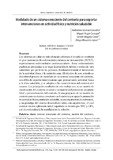Mostrar el registro sencillo del ítem
Modelado de un sistema consciente del contexto para soportar intervenciones en actividad física y nutrición saludable
Modeling of a context-aware system to support interventions in physical activities and healthy nutrition
| dc.contributor.author | González, Katherine Xiomar | |
| dc.contributor.author | Carvajal, Miguel Angel | |
| dc.contributor.author | Cerón, Gineth Magaly | |
| dc.contributor.author | López, Diego Mauricio | |
| dc.date.accessioned | 2017-06-29T22:22:36Z | |
| dc.date.available | 2017-06-29T22:22:36Z | |
| dc.date.created | 2016-06-30 | |
| dc.identifier.issn | 1692-3324 | |
| dc.identifier.uri | http://hdl.handle.net/11407/3551 | |
| dc.description.abstract | Los sistemas de salud en todo el mundo afrontan el desafío de combatir el gran incremento de enfermedades crónicas no transmisibles (ECNT), especialmente enfermedades cardiovasculares. Estas enfermedades pueden ser prevenidas si se logra la adopción de hábitos y estilos de vida saludables por parte de las personas, fundamentalmente el incremento de la actividad física y la nutrición sana. El objetivo de este artículo es describir el proceso de modelado de un sistema consciente del contexto, con el fin de soportar intervenciones que promuevan la actividad física y dieta saludable y se adapten a las características del contexto del usuario. Los principales resultados de este trabajo son a) un modelo de clasificación del contexto en salud y un modelo del proceso de adaptabilidad y personalización del contexto, b) una propuesta de un modelo de contexto para un sistema consciente en el contexto que apoye la promoción de actividad física y nutrición saludable, c) una arquitectura de referencia y un prototipo del sistema desarrollado sobre esta arquitectura, el cual consiste en una aplicación móvil soportada en tecnologías NFC y GPS y d) la evaluación de la usabilidad de la solución. | spa |
| dc.description.abstract | Health systems around the world are currently facing a challenge to fight the tremendous growth of non-transmissible chronic diseases (NTCD), especially cardiovascular diseases. These diseases can be prevented if adoption of healthy habits and lifestyles are adopted by people, specifically by increasing their physical activity and having a healthy nutrition. The objective of this article is to describe the modeling process of a contextaware system with the purpose of supporting interventions to promote physical activity and healthy nutrition, duly adjusted to the characteristics of the user’s context. The main results of this article are: a) a classification model of health context and a context adaptability and personalization process model; b) a proposal of a context model for a context-aware system, which supports the promotion of physical activity and healthy nutrition; c) a reference architecture and a prototype of the system developed on such architecture, which consists of a mobile application supported by NFC and GPS technologies; and d) an evaluation of the solution usability. | spa |
| dc.format.extent | p. 173-196 | spa |
| dc.format.medium | Electrónico | spa |
| dc.format.mimetype | application/pdf | |
| dc.language.iso | spa | |
| dc.publisher | Universidad de Medellín | spa |
| dc.relation.uri | http://revistas.udem.edu.co/index.php/ingenierias/article/view/1070 | |
| dc.rights.uri | http://creativecommons.org/licenses/by-nc-sa/4.0/ | * |
| dc.source | Revista Ingenierías Universidad de Medellín; Vol. 15, núm. 28 (2016) | spa |
| dc.source | 2248-4094 | spa |
| dc.source | 1692-3324 | spa |
| dc.subject | Context-aware system | spa |
| dc.subject | Context model | spa |
| dc.subject | Context data | spa |
| dc.subject | NFC | spa |
| dc.subject | GPS | spa |
| dc.subject | Sistema consciente del contexto | spa |
| dc.subject | Modelo del Contexto | spa |
| dc.subject | Datos del contexto | spa |
| dc.subject | NFC | spa |
| dc.subject | GPS. | spa |
| dc.title | Modelado de un sistema consciente del contexto para soportar intervenciones en actividad física y nutrición saludable | spa |
| dc.title | Modeling of a context-aware system to support interventions in physical activities and healthy nutrition | spa |
| dc.type | Article | eng |
| dc.rights.accessrights | info:eu-repo/semantics/openAccess | |
| dc.identifier.doi | http://dx.doi.org/10.22395/rium.v15n28a9 | |
| dc.relation.citationvolume | 15 | |
| dc.relation.citationissue | 28 | |
| dc.relation.citationstartpage | 173 | |
| dc.relation.citationendpage | 196 | |
| dc.audience | Comunidad Universidad de Medellín | spa |
| dc.publisher.faculty | Facultad de Ingenierías | spa |
| dc.coverage | Lat: 06 15 00 N degrees minutes Lat: 6.2500 decimal degreesLong: 075 36 00 W degrees minutes Long: -75.6000 decimal degrees | spa |
| dc.publisher.place | Medellín | spa |
| dc.creator.affiliation | González, Katherine Xiomar; Universidad del Cauca | spa |
| dc.creator.affiliation | Carvajal, Miguel Angel; Universidad del Cauca | spa |
| dc.creator.affiliation | Cerón, Gineth Magaly; Universidad del Cauca | spa |
| dc.creator.affiliation | López, Diego Mauricio; Universidad del Cauca | spa |
| dc.relation.references | WHO, “Informe sobre la situación mundial de las enfermedades no transmisibles 2014”, [En línea], Organización Mundial de la Salud, acceso 11 de junio, 2015; Disponible: http://apps.who.int/iris/bitstream/10665/149296/1/WHO_NMH_NVI_15.1_spa.pdf?ua=1&ua=1. | spa |
| dc.relation.references | WHO, “Global action plan for the prevention and control of NCDs 2013-2020”, [En línea], Organización Mundial de la Salud, pp. 55, acceso 11 de junio, 2015; Disponible: http://www.who.int/nmh/publications/ncd-action-plan/en/ | spa |
| dc.relation.references | WHO, “Promoción de la salud y modos de vida sanos,” en Resoluciones y Desiciones, Octava sesión plenaria, pp. 37-39, 22 de mayo de 2004 - Comisión A, tercer informe | spa |
| dc.relation.references | M, Barrera Perdomo, “Alimentación y nutrición en dislipidemias, síndrome metabólico y enfermedad cardiovascular,” Salud Pública Y Nutrición Humana, pp. 240, 2015. | spa |
| dc.relation.references | M. P. Cugelman B1, “Online interventions for social marketing health behavior change campaigns: a meta-analysis of psychological architectures and adherence factors,” J Med Internet Res, vol. 1, p. 13, 2011. | spa |
| dc.relation.references | G. Cerón Ríos, “Sistema Adaptativo para el Apoyo a Programas de Promoción de Actividad física y Alimentación saludable,” Anteproyecto de Tesis de Doctorado, Universidad del Cauca, Popayán, Colombia. Diciembre 2014. | spa |
| dc.relation.references | T. Lovett, “Sensing and Interactive Intelligence in Mobile Context Aware Systems,” p. 290, Diciembre 2012. | spa |
| dc.relation.references | D. ANIND K, “Understanding and Using Context,” Personal and Ubiquitous Computing, 2001. | spa |
| dc.relation.references | J. M. Gómez Pérez, M. Grobelnik, C. Ruiz, M. Tilly y P. Warren, “Using Task Context to Achieve Effective Information Delivery,” p. 6, 2009. | spa |
| dc.relation.references | B. N. Schilit, N. Adams y R. Want, “Context-Aware Computing Applications,” Mobile Computing Systems and Applications, pp. 85-90, 1994. | spa |
| dc.relation.references | N. Bricon-Souf y C. R. Newman, “Context awareness in health care: A review,” international journal of medical informatics, vol. 76, n.º 1, pp. 2-12, 2007. | spa |
| dc.relation.references | C. Mettouris, y G. Papadopoulos Contextual, “Modelling in Context-Aware Recommender Systems: A Generic Approach,” Web Information Systems Engineering–WISE 2011 and 2012 Workshops, Springer Berlin Heidelberg, 2013, pp. 41-52 | spa |
| dc.relation.references | M. Alhamid, “Towards Context-Aware Personalized Recommendations in an Ambient Intelligence Environment”, Tesis Doctoral, Universidad of Ottawa, 2015 | spa |
| dc.relation.references | F. Buttussi y L. Chittaro, “MOPET: a context-aware and user-adaptive wearable system for fitness training,” Artif Intell Med, vol. 42, 2008. | spa |
| dc.relation.references | Shih, Chia-Hung, Wakabayashi, N, Yamamura, S, Chen y C.Y, “A context model with a time-dependent multi-layer exception handling policy,” International Journal of Innovative Computing, Information and Control, vol. 7, n.º 5A, pp. 2225-2234, 2011. | spa |
| dc.relation.references | “Engineering Research Methodology,” DigitalOfficePro, 2015. [En línea]. Disponible: http://www.slideserve.com/donnan/engineering-research-methodology. [Último acceso: 17 marzo 2015]. | spa |
| dc.relation.references | E. Astigarra, “Método Delphi,” Universidad Deusto, 2011. | spa |
| dc.relation.references | R. Galeano, “Diseño centrado en el usuario,” Revista q, vol. 2, n.º 4, pp. 1-15, 2008. | spa |
| dc.relation.references | H. Ailisto, P. Alahuhta, V. Haataja, V. Kyllönen y M. Lindholm, “Structuring Context Aware Applications: Five-Layer Model and Example Case,” HJA, vol. 0, n.º 11, p. 5, agosto 2002. | spa |
| dc.relation.references | C. Bauer y S. Spiekermann, “Conceptualizing context for adaptive pervasive commerce,” European Conference on Information Systems (ECIS), p. 13, octubre 2011. | spa |
| dc.relation.references | O. S. M. K.-P. C. S. S. N. Salma Najar, “Semantic Representation of Context Models: A Framework for analyzing and understanding,” N/P, vol. 1, p. 10, octubre 2009. | spa |
| dc.relation.references | “Organización Mundial de la Salud,” OMS [En línea]. Disponible: http://www.who.int/topics/risk_factors/es/, 2015 [Último acceso: 20 marzo 2015]. | spa |
| dc.relation.references | O. Coutand, “A Framework for Contextual Personalized Applications,” Kassel University Press GmbH, noviembre 2008. | spa |
| dc.relation.references | R. A. Rodriguez, P. M. Vera, M. R. Martínez, D. A. Giulianelli y F. E. Valles, “Context Aware Applications on Mobile Environments-Engaged by the use of NFC,” 2013. | spa |
| dc.relation.references | “About the Technology, NFC and Contactless Technologies,” NFC FORUM, [En línea]. Disponible: http://nfc-forum.org/what-is-nfc/about-the-technology/, 2015, [Último acceso: 23 marzo 2015]. | spa |
| dc.rights.creativecommons | Attribution-NonCommercial-ShareAlike 4.0 International | * |
| dc.identifier.eissn | 2248-4094 | |
| dc.type.coar | http://purl.org/coar/resource_type/c_6501 | |
| dc.type.version | info:eu-repo/semantics/publishedVersion | |
| dc.type.local | Artículo científico | spa |
| dc.type.driver | info:eu-repo/semantics/article | |
| dc.identifier.reponame | reponame:Repositorio Institucional Universidad de Medellín | spa |
| dc.identifier.repourl | repourl:https://repository.udem.edu.co/ | |
| dc.identifier.instname | instname:Universidad de Medellín | spa |
| dc.relation.ispartofjournal | Revista Ingenierías Universidad de Medellín | spa |



